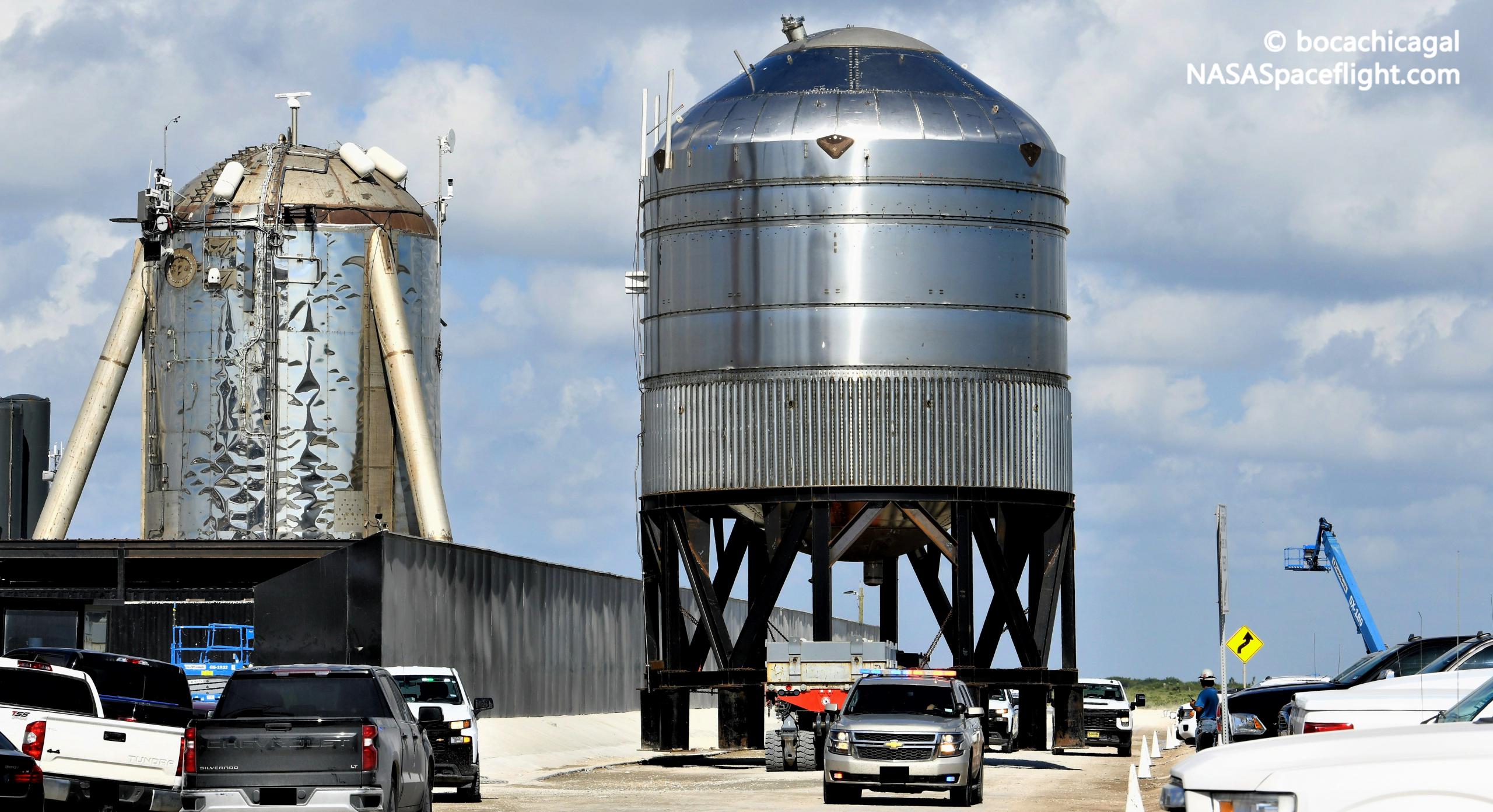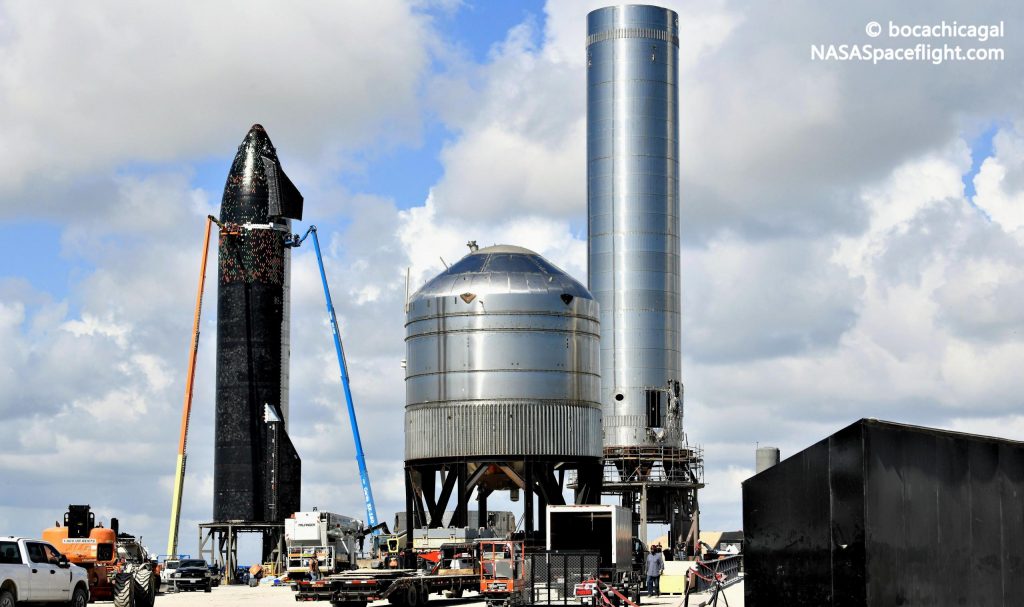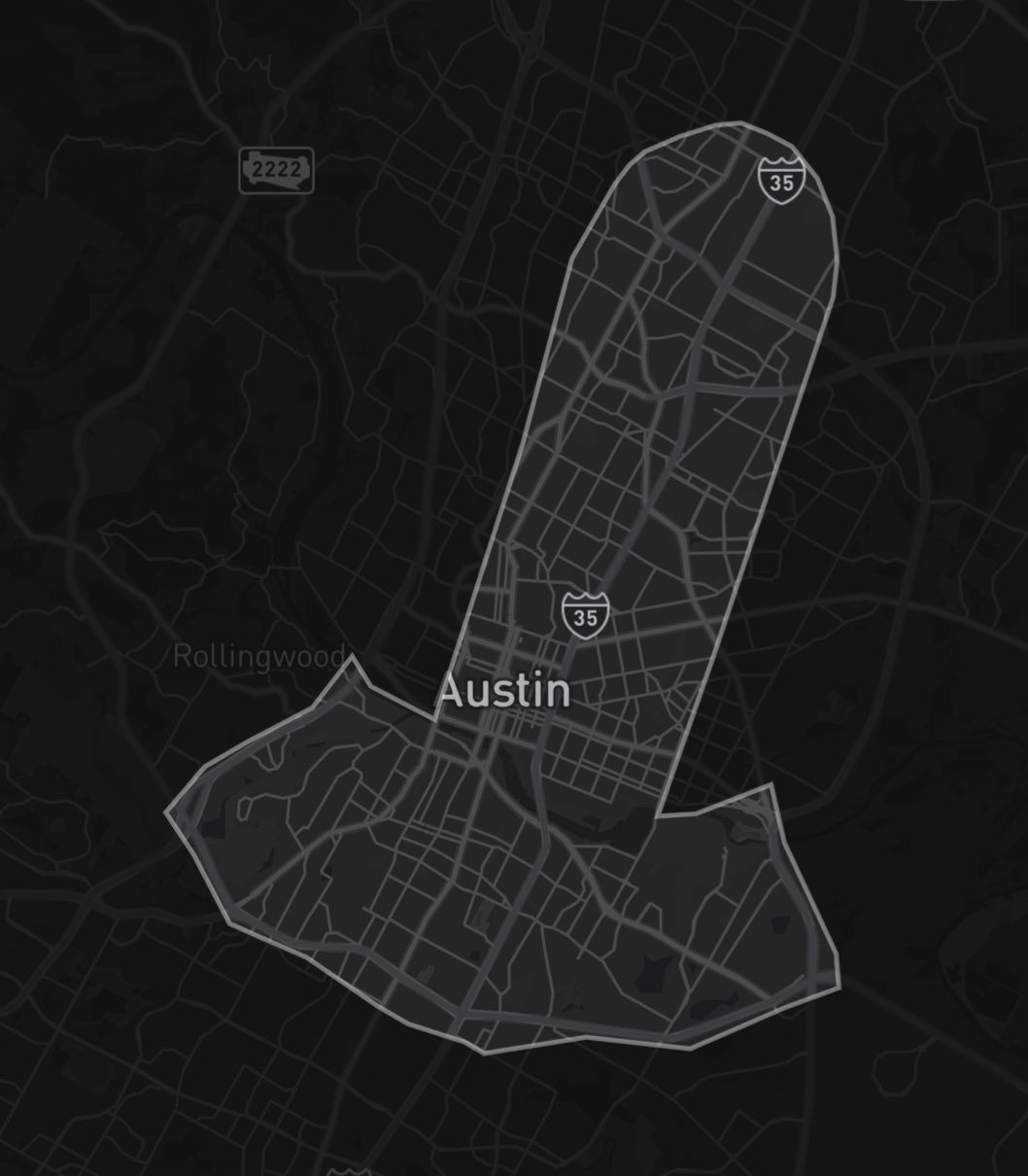

News
SpaceX to put custom Starship propellant storage tanks through first trial
In the latest twist in the saga of SpaceX’s custom-built Starship launch pad propellant storage tanks, the company appears to have retroactively decided to build small prototype meant solely for testing.
Known as a ‘test tank,’ the relatively small steel structure was fairly rapidly assembled from parts of an older Ground Support Equipment (GSE) tank scrapped in July over the last week or so. SpaceX completed the first Starship-derived propellant storage tank in April 2021 and rapidly rolled that tank (GSE1) and a second (GSE2) from the build site to the orbital launch pad just a few weeks apart. Less than a month after that, SpaceX also completed GSE tank #3, though things seemingly devolved into chaos immediately thereafter.
Only three months later would GSE3 finally be transported to – and installed on a concrete mount at – Starship’s first orbital launch site, and only after a number of structural modifications and in the footsteps of GSE tanks #5 and #6. Little is known about why SpaceX’s custom GSE tank production faltered so soon after it began, why none of the five Starship-sized tanks installed at the orbital pad have been fully plumbed or subjected to any kind of testing, or why structural modifications were seemingly required after the fact. However, it’s safe to say that SpaceX’s brand new GSE ‘test tank’ is now at the center of the mystery.

Thankfully, at minimum, the rapid appearance of SpaceX’s first GSE test tank returns some level of familiarity to the brief but chaotic history of Starship’s orbital launch pad propellant tanks. Test tanks are nothing new and have been an integral part of Starship development since Test Tank 1 first headed to SpaceX’s suborbital launch (and test) facilities in January 2020. In the 20 months since, SpaceX has built and tested seven small test tanks, several of which didn’t survive.
Whether intentionally destroyed or not, each test tank explicitly helped SpaceX qualify new manufacturing techniques, different materials, and different skin thickness and generally gather data more quickly and cheaply than full-scale prototypes would allow. Most recently, for example, SpaceX seemingly successfully tested a Super Heavy booster test tank, subjecting the prototype to cryogenic liquid nitrogen and using hydraulic rams to simulate the thrust of nine Raptor engines on an unproven disk-like thrust structure.
Now, almost as if SpaceX snapped out of a trance and remembered the utility of test tanks, the company has assembled a subscale GSE prototype presumably meant to verify that its custom-built propellant storage tanks can handle a set of conditions significantly different from the Starships they’re derived from. In this case, that GSE tank was quite literally built from scrapped sections of GSE tank #4. In fact, the top half (forward dome section) was quite literally cut off of GSE4 after the tank was scrapped last month for unknown reasons.
Over the last several months, while GSE tank production and installation took an unexpected hiatus, SpaceX workers slowly but surely welded steel rings (stiffeners) to the exterior of GSE1, GSE2, and GSE3. When GSE5 and GSE6 eventually headed to the pad, they left with those stiffeners already installed, implying that whatever tripped SpaceX up was likely structural. The GSE4 test tank also includes external stiffeners along each circumferential weld (where rings were stacked or domes joined).


At the same time as SpaceX was (or wasn’t, for several months) building its own GSE tanks, contractors normally tasked with assembling water towers and storage tanks in situ built eight massive 12m (~40 ft) wide tanks of their own. Deemed “cryo shells,” much like their name suggests, those tanks are meant to fully enclose SpaceX’s GSE tanks. SpaceX will use those shells to insulate their thin, single-walled steel propellant tanks, thus keeping their cryogenic contents cryogenic for as long as possible. How they’ll be insulated is unclear, though.
Based on the seemingly retroactive decision to strengthen the exterior of those GSE tanks, the general consensus as of late is that SpaceX wants to pull at least a partial vacuum in the gap between shell and tank. It’s also possible that SpaceX will do the opposite and pressurize that gap (as much as possible) with an insulative gas like nitrogen. Extra confusion comes from the fact that Starship tanks are technically designed to support a literal spacecraft (operating in a near-total vacuum) without the need for external stiffeners.
Additionally, it’s fairly clear that SpaceX hasn’t built a custom subscale cryoshell or concrete installation pad for its GSE4 test tank, meaning that it will really only be useful for testing some of the loads operational GSE tanks will experience inside their sleeves. Additionally, given that SpaceX has already completed six of the orbital pad’s seven GSE tanks and all seven of their cryosleeves, the discovery of any significant issues during GSE4 testing could easily trigger months of rework and delays. With any luck, though, GSE4 will sail through an imminent test campaign, clearing the way for SpaceX to finish plumbing, sleeving, and activating Starship’s first orbital launch site tank farm.
Elon Musk
Tesla’s Robotaxi expansion wasn’t a joke, it was a warning to competitors
Tesla might have made a joke with its first Robotaxi service area expansion, but it was truly a serious warning to its competitors.

Tesla’s Robotaxi expansion occurred for the first time on Monday, and while the shape of its new service area might be “cocky,” it surely is not a joke. It’s a warning to competitors.
Robotaxi skeptics and Tesla opponents are sitting around throwing hate toward the company’s expansion appearance. Some called it “unserious,” and others say it’s “immature.” The reality is that it has a real meaning that goes much further than the company’s lighthearted and comical attitude toward things.
Proudly unserious
— Tesla (@Tesla) July 14, 2025
For context, Tesla has routinely used the number 69 as a way to price things it sells. 420 is another, an ode to cannabis culture. A few years back, it actually priced its Model S flagship sedan at $69,420. The first rides of the Robotaxi fleet were priced at $4.20. They are now being increased to $6.90.
Some call it childish. Others call it fun. The truth is, nobody is doing it this way.
Tesla updates Robotaxi app with several big changes, including wider service area
But today’s expansion of the Robotaxi service area in Austin is different. Tesla did not expand its shape to different neighborhoods or areas of the City of Austin. It did not expand it by broadening the rectangle that was initially available. Instead, it chose a different strategy, simply because it could:
🚨 Tesla’s new Robotaxi geofence is…
Finish the sentence 🥸 pic.twitter.com/3bjhMqsRm5
— TESLARATI (@Teslarati) July 14, 2025
Tesla could have done anything. It could have expanded in any direction, in any way, but it chose this simply because it has gotten Robotaxi to the point that it can broaden its service area in any direction. It chose this shape because it could.
Other companies might not have the same ability. Of course, many companies probably would not do this even if it could, simply because of the optics. Tesla doesn’t have those concerns; it has been open about its ability to be funny, and yes, immature, at times.
But in reality, it was a stark warning to competitors. “We can go anywhere in Austin, at any time, and we’re confident enough to make a joke about it.”
Tesla’s Robotaxi geofence in Austin grows, and its shape is hard to ignore
As Tesla is already aiming to expand to new states and high-population areas, and with applications filed in Arizona and California, Robotaxi will be in new regions in the coming weeks or months.
For now, it remains in Austin, and Tesla is sending a message to other companies that it is ready to go in any direction. The driverless Robotaxi fleet, bolstered by billions of miles of data, is ready to roam without anyone at the wheel.
News
Tesla Robotaxi has already surpassed Waymo in this key metric
Tesla Robotaxi has already overtaken Waymo in Austin in one key metric, but there’s still more work to do.

Tesla Robotaxi has already surpassed Waymo in one extremely important key metric: size of service area.
Tesla just expanded its service area in Austin on Monday morning, pushing the boundaries of its Robotaxi fleet in an interesting fashion with new capabilities to the north. Yes, we know what it looks like:
🚨 Tesla’s new Robotaxi geofence is…
Finish the sentence 🥸 pic.twitter.com/3bjhMqsRm5
— TESLARATI (@Teslarati) July 14, 2025
The expansion doubled Tesla Robotaxi’s potential travel locations, which now include the University of Texas at Austin, a school with over 53,000 students.
The doubling of the service area by Tesla has already made its travel area larger than Waymo’s, which launched driverless rides in October 2024. It became available to the public in March 2025.
According to Grok, the AI agent on X, Tesla Robotaxi’s current service area spans 42 square miles, which is five square miles larger than Waymo’s service area of 37 square miles.
Tesla Robotaxi (red) vs. Waymo geofence in Austin.
Much can be said about the shape… but the Robotaxi area is now ~3.9 mi² (10 km²) larger than Waymo’s!! pic.twitter.com/dVfh2ODxJC
— Robin (@xdNiBoR) July 14, 2025
The service area is one of the most important metrics in determining how much progress a self-driving ride-hailing service is making. Safety is the priority of any company operating a ride-hailing network, especially ones that are making it a point to use autonomy to deploy it.
However, these companies are essentially racing for a larger piece of the city or cities they are in. Waymo has expanded to several different regions around the United States, including Arizona and Los Angeles.
Tesla is attempting to do the same in the coming months as it has already filed paperwork in both California and Arizona to deploy its Robotaxi fleet in states across the U.S.
As the platform continues to show more prowess and accuracy in its operation, Tesla will begin to expand to new areas, eventually aiming for a global rollout of its self-driving service.
News
Tesla Megapacks arrive for massive battery replacing coal plant
Tesla Megapacks have started arriving on-site to the Stanwell Battery Project, just as Queensland prepares to wind down the Stanwell coal plant.

The first of over 300 Tesla Megapacks have arrived to the site of a massive battery energy storage system (BESS) being built in Australia, dubbed the Stanwell Battery Project after a coal plant it’s set to replace.
In a press release last week, the Stanwell Battery Project announced that the first Tesla Megapack 2XL units had arrived to the site, which is located outside of Rockhampton in Queensland, Australia. The project will eventually feature 324 Megapack units, set to arrive in the coming months, in order to support the 300MW/1,200MWh battery project.
“The Stanwell Battery is part of the diversification of our portfolio, to include cleaner and more flexible energy solutions,” said Angie Zahra, Stanwell Central Generation General Manager. “It is just one part of the 800 MW of battery energy storage capacity we have in our pipeline.
“Capable of discharging 300 MW of energy for up to four hours (1,200 MWh), our mega battery will be one of the largest in Queensland.”

Credit: Stanwell
Did you know Tesla’s Lathrop facility churns out a Megapack every 68 minutes? That’s enough energy to power 3,600 homes for an hour per unit! ⚡️ pic.twitter.com/bG6fpHkB9O
— TESLARATI (@Teslarati) June 11, 2025
READ MORE ON TESLA MEGAPACKS: Tesla Lathrop Megafactory celebrates massive Megapack battery milestone
The state is working with government-owned company Yurika to facilitate construction, and the process is expected to create roughly 80 jobs. The project is expected to come fully online in May 2027, with initial commissioning of the Megapacks aiming for November 2025.
The Stanwell Battery is set to replace the nearby Stanwell coal generation plant, which the government is planning to wind down starting in 2026 as part of efforts to reach an 80 percent renewable energy generation ratio by 2035. Meanwhile, the government is also set to begin winding down the Tarong and Callide coal plants, while several other Megapack projects are being built or coming online. o ya
Tesla currently has two Megapack production facilities, located in Lathrop, California, in the U.S. and another that came online earlier this year in Shanghai, China. The Shanghai Megafactory shipped its first units to Australia in March, while both factories are expected to be capable of producing 10,000 Megapack units per year upon reaching volume production.
-

 Elon Musk2 weeks ago
Elon Musk2 weeks agoTesla investors will be shocked by Jim Cramer’s latest assessment
-

 News2 days ago
News2 days agoTesla debuts hands-free Grok AI with update 2025.26: What you need to know
-

 Elon Musk5 days ago
Elon Musk5 days agoxAI launches Grok 4 with new $300/month SuperGrok Heavy subscription
-

 Elon Musk7 days ago
Elon Musk7 days agoElon Musk confirms Grok 4 launch on July 9 with livestream event
-

 News2 weeks ago
News2 weeks agoTesla Model 3 ranks as the safest new car in Europe for 2025, per Euro NCAP tests
-

 Elon Musk2 weeks ago
Elon Musk2 weeks agoxAI’s Memphis data center receives air permit despite community criticism
-

 News4 days ago
News4 days agoTesla begins Robotaxi certification push in Arizona: report
-

 Elon Musk2 weeks ago
Elon Musk2 weeks agoTesla scrambles after Musk sidekick exit, CEO takes over sales

















